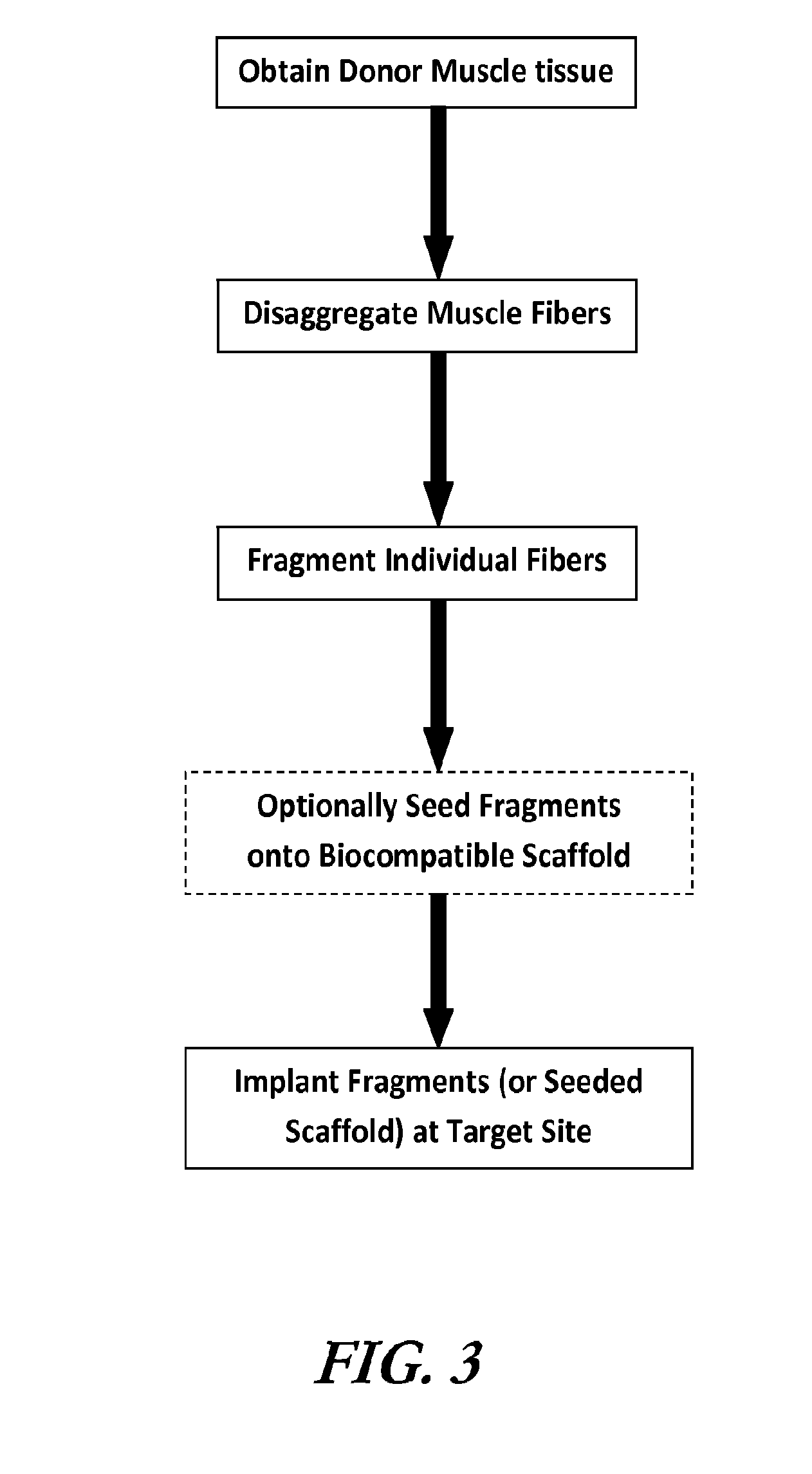Muscle tissue regeneration using muscle fiber fragments
- Summary
- Abstract
- Description
- Claims
- Application Information
AI Technical Summary
Benefits of technology
Problems solved by technology
Method used
Image
Examples
example 1
Preparation of Muscle Fiber Fragments
[0098]Uniformly structured muscle fiber fragments were isolated from tibialis anterior (TA) and gastrocnemius (GN) muscles of C57BL6 mice (male, 10-12 weeks). Isolated TA or GN muscles were minced with two disposable scalpels. The muscle tissue was minced into quite small sizes. After mincing, the fragments were digested with 0.2% collagenase type I in serum free DMEM with shaking at 37° C. for 1 hr. After enzymatic digestion, myofibers were pipetted to dissociate into individual fragments. Subsequently, the myofibers solution was immediately filtered through a cell strainer (100 μm size, BD falcon) to obtain uniform sized myofiber fragments.
Small myofiber fragments were labeled with Vybrant fluorescent dye (DiD, Invitrogen) for fiber tracking after implantation in animals. Confocal microscopy confirmed that isolated fiber fragments including cells on their surface were fluorescently labeled with Vybrant and the size of fiber fragments showed app...
example 2
Transplant of Muscle Fiber Fragments
[0099]To determine whether the processed muscle fragments can be developed as an injection therapy, isolated muscle fiber fragments were injected to the gluteal region of C57BL6 mice (10-12 weeks). 10 μl of fiber fragments solution in PBS (500 in fiber fragment numbers / injection) were injected twice toward the incision site (0.5-1 cm) on the gluteal region with a hamilton syringe (26 G, 10 μl). After transplantation, the incision was closed by suture. At 1, 2, 3, and 4 weeks after transplantation, the muscle tissue with incision site was harvested and further frozen in OCT compounds.
[0100]To examine whether injected muscle fiber fragments would reassemble into host muscle fibers and integrate with vascular and neural system of host animal, histological and immunohistological studies were performed using the harvest tissues. The frozen tissues were sectioned and fixed with 10% formalin solution for H&E staining. For immunohistochemical study of the...
example 3
Comparison of Transplantation Efficiencies of Muscle Fiber Fragments, Long Fibers and Acellularized Tissue Components
[0102]A study to compare the in vivo effect of decellularized fragments and fragments containing satellite cells was performed. Encouraged by the promising results from in vivo mouse study, an extended animal study using rats was performed in order to determine efficient engraftment of small fiber fragments when compared to that of long fibers using various injection volume and numbers of fiber fragments. Additionally, acellular fragments without cellular components were transplanted to examine possibility of their use as “off-the shelf” components for allogeneic transplantation. Muscle fiber fragments from rats (Lewis rats, 10-12 weeks) were isolated using the same protocols as described above for mice. Various volumes (100, 200, and 300 μL) of fiber fragments (7×104 fibers / ml) were injected to gastrocnemius (GN) muscles without any muscle defects using a syringe wit...
PUM
| Property | Measurement | Unit |
|---|---|---|
| Fraction | aaaaa | aaaaa |
| Time | aaaaa | aaaaa |
| Size | aaaaa | aaaaa |
Abstract
Description
Claims
Application Information
 Login to View More
Login to View More - R&D
- Intellectual Property
- Life Sciences
- Materials
- Tech Scout
- Unparalleled Data Quality
- Higher Quality Content
- 60% Fewer Hallucinations
Browse by: Latest US Patents, China's latest patents, Technical Efficacy Thesaurus, Application Domain, Technology Topic, Popular Technical Reports.
© 2025 PatSnap. All rights reserved.Legal|Privacy policy|Modern Slavery Act Transparency Statement|Sitemap|About US| Contact US: help@patsnap.com



